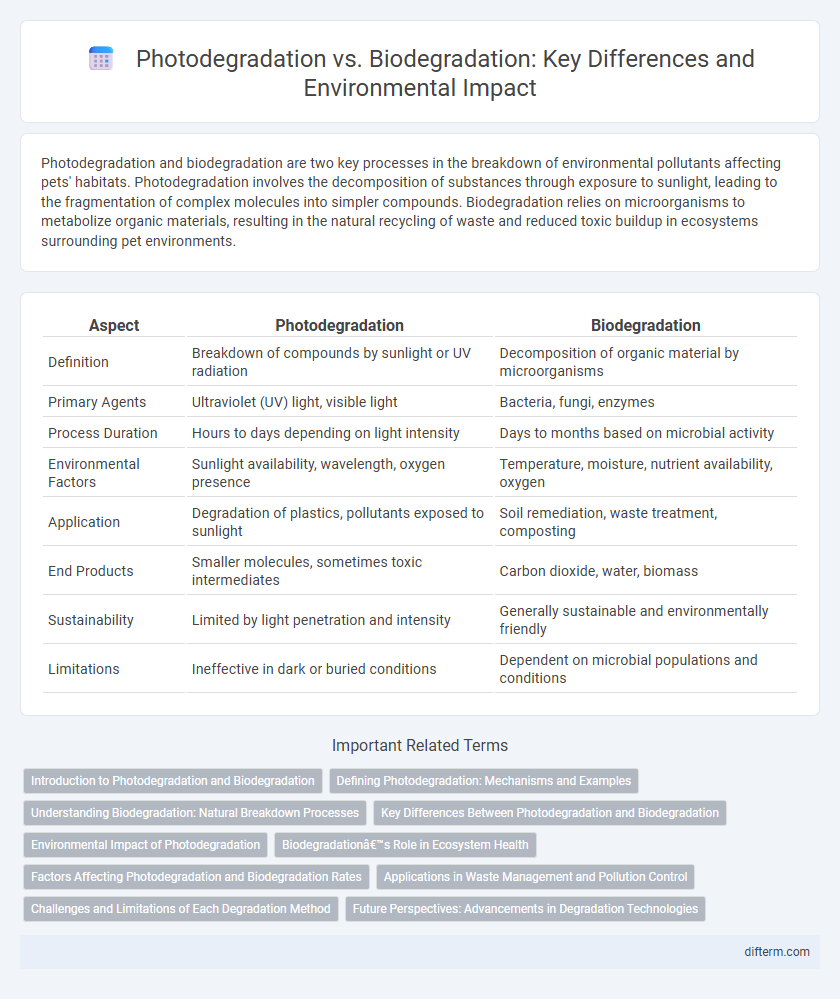Photodegradation and biodegradation are two key processes in the breakdown of environmental pollutants affecting pets' habitats. Photodegradation involves the decomposition of substances through exposure to sunlight, leading to the fragmentation of complex molecules into simpler compounds. Biodegradation relies on microorganisms to metabolize organic materials, resulting in the natural recycling of waste and reduced toxic buildup in ecosystems surrounding pet environments.
Table of Comparison
| Aspect | Photodegradation | Biodegradation |
|---|---|---|
| Definition | Breakdown of compounds by sunlight or UV radiation | Decomposition of organic material by microorganisms |
| Primary Agents | Ultraviolet (UV) light, visible light | Bacteria, fungi, enzymes |
| Process Duration | Hours to days depending on light intensity | Days to months based on microbial activity |
| Environmental Factors | Sunlight availability, wavelength, oxygen presence | Temperature, moisture, nutrient availability, oxygen |
| Application | Degradation of plastics, pollutants exposed to sunlight | Soil remediation, waste treatment, composting |
| End Products | Smaller molecules, sometimes toxic intermediates | Carbon dioxide, water, biomass |
| Sustainability | Limited by light penetration and intensity | Generally sustainable and environmentally friendly |
| Limitations | Ineffective in dark or buried conditions | Dependent on microbial populations and conditions |
Introduction to Photodegradation and Biodegradation
Photodegradation involves the breakdown of materials through exposure to sunlight, primarily ultraviolet (UV) radiation, which causes chemical changes in polymers and organic compounds. Biodegradation, on the other hand, relies on microorganisms such as bacteria and fungi to decompose substances into simpler, non-toxic molecules through enzymatic processes. Both processes play critical roles in environmental waste management by naturally reducing plastic pollution and organic waste.
Defining Photodegradation: Mechanisms and Examples
Photodegradation is a process where sunlight, especially ultraviolet (UV) radiation, breaks down chemical compounds into smaller molecules through photochemical reactions. This mechanism commonly affects pollutants like pesticides, plastics, and dyes, initiating molecular changes that reduce environmental persistence. For example, polyethylene terephthalate (PET) plastics exposed to sunlight degrade via photodegradation, fragmenting into microplastics and simpler compounds before further environmental processing.
Understanding Biodegradation: Natural Breakdown Processes
Biodegradation involves the natural breakdown of organic materials by microorganisms such as bacteria and fungi, leading to the conversion of pollutants into harmless substances like water, carbon dioxide, and biomass. This process is crucial for soil health and is influenced by environmental factors including temperature, moisture, and oxygen availability. Unlike photodegradation, which relies on sunlight to decompose materials, biodegradation works effectively in dark and anaerobic conditions, making it essential for waste management and ecosystem sustainability.
Key Differences Between Photodegradation and Biodegradation
Photodegradation involves the breakdown of materials by ultraviolet (UV) light exposure, primarily affecting plastics and pollutants in the atmosphere. Biodegradation relies on microorganisms such as bacteria and fungi to decompose organic substances into simpler compounds, contributing to soil health and nutrient cycling. The key differences lie in their mechanisms: photodegradation is driven by sunlight-induced chemical reactions, whereas biodegradation depends on biological processes within ecosystems.
Environmental Impact of Photodegradation
Photodegradation significantly alters pollutants by breaking down chemical compounds using sunlight, leading to the formation of potentially toxic byproducts that can accumulate in soil and water ecosystems. This process accelerates the transformation of plastics, pesticides, and other contaminants but may release harmful substances like microplastics and persistent organic pollutants (POPs) that affect aquatic and terrestrial life. The environmental impact of photodegradation underscores the importance of monitoring degradation pathways to mitigate long-term ecological risks associated with pollutant persistence and toxicity.
Biodegradation’s Role in Ecosystem Health
Biodegradation plays a crucial role in maintaining ecosystem health by breaking down organic materials through microbial activity, which recycles nutrients essential for soil fertility and plant growth. Unlike photodegradation, which relies on sunlight to decompose materials and primarily affects surface pollutants, biodegradation processes occur naturally in soils, sediments, and aquatic environments, supporting long-term ecosystem stability. Effective biodegradation reduces harmful waste accumulation, promotes biodiversity, and sustains the balance of microbial communities critical for ecosystem resilience.
Factors Affecting Photodegradation and Biodegradation Rates
Photodegradation rates are influenced by factors such as light intensity, wavelength, temperature, and the presence of photosensitizers or oxygen, which accelerate the breakdown of materials exposed to sunlight. Biodegradation depends on environmental conditions including temperature, moisture, pH, nutrient availability, and the presence of microbial communities capable of metabolizing the substrate. Both processes are significantly affected by the chemical structure of the material, with more complex or synthetic polymers generally degrading slower in natural environments.
Applications in Waste Management and Pollution Control
Photodegradation accelerates the breakdown of pollutants and plastics in waste management through light-induced chemical reactions, enabling faster decomposition under environmental exposure. Biodegradation employs microbial activity to convert organic waste and hazardous substances into harmless byproducts, promoting sustainable pollution control in soil and water ecosystems. Integrating photodegradation and biodegradation techniques enhances efficiency in treating complex waste streams and reducing environmental contamination.
Challenges and Limitations of Each Degradation Method
Photodegradation often faces challenges such as dependency on sunlight exposure and limited effectiveness in shaded or indoor environments, leading to incomplete breakdown of pollutants. Biodegradation encounters limitations including the requirement for specific microbial communities and optimal environmental conditions like temperature and moisture, which can slow the degradation process. Both methods struggle with the persistence of complex synthetic compounds that resist natural degradation pathways.
Future Perspectives: Advancements in Degradation Technologies
Emerging photodegradation technologies leverage advanced photocatalysts such as titanium dioxide and visible-light-active materials to accelerate breakdown of persistent pollutants with higher efficiency and lower energy consumption. Innovations in biodegradation harness genetically engineered microbes and enzymatic formulations tailored to metabolize complex synthetic compounds, enhancing degradation rates and environmental specificity. Integrating photodegradation and biodegradation processes within hybrid systems shows promise for scalable, sustainable waste management solutions to mitigate plastic accumulation and chemical pollution in diverse ecosystems.
photodegradation vs biodegradation Infographic

 difterm.com
difterm.com